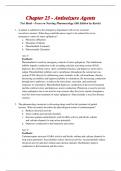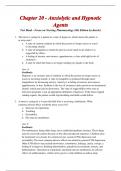Examsrevision
On this page, you find all documents, package deals, and flashcards offered by seller ExamsRevision.
- 1082
- 0
- 127
Community
- Followers
- Following
23 Reviews received
1209 items

Test Bank - Focus on Nursing Pharmacology (8th Edition by Karch) |Chapters 21-25|
Chapter 21 Antidepressant Agents Chapter 22 Psychotherapeutic Agents Chapter 23 Antiseizure Agents Chapter 24 Antiparkinsonism Agents Chapter 25 Muscle Relaxants
- Package deal
- • 5 items •
- Chapter 21 - Antidepressant Agents |Test Bank - Focus on Nursing Pharmacology (8th Edition by Karch) • Exam (elaborations)
- Chapter 23 - Antiseizure Agents |Test Bank - Focus on Nursing Pharmacology (8th Edition by Karch) • Exam (elaborations)
- Chapter 22 - Psychotherapeutic Agents |Test Bank - Focus on Nursing Pharmacology (8th Edition by Karch) • Exam (elaborations)
- Chapter 24 - Antiparkinsonism Agents |Test Bank - Focus on Nursing Pharmacology (8th Edition by Karch) • Exam (elaborations)
- Chapter 25 - Muscle Relaxants |Test Bank - Focus on Nursing Pharmacology (8th Edition by Karch) • Exam (elaborations)
Chapter 21 Antidepressant Agents Chapter 22 Psychotherapeutic Agents Chapter 23 Antiseizure Agents Chapter 24 Antiparkinsonism Agents Chapter 25 Muscle Relaxants

Chapter 25 - Muscle Relaxants |Test Bank - Focus on Nursing Pharmacology (8th Edition by Karch)
1. The nurse is teaching a class on muscular coordination and explains it is the movement of what electrolyte that contributes to the process of muscle contraction and relaxation? a. Calcium b. Chloride c. Magnesium d. Hydrogen Ans: A Feedback: Calcium is released from the sarcoplasmic reticulum, which leads to the binding of calcium with troponintropomyosin. This leads to contraction of the muscle fiber. The calcium pump then moves calcium back into the sarcoplasmic reticulum, which le...
- Package deal
- Exam (elaborations)
- • 13 pages •
1. The nurse is teaching a class on muscular coordination and explains it is the movement of what electrolyte that contributes to the process of muscle contraction and relaxation? a. Calcium b. Chloride c. Magnesium d. Hydrogen Ans: A Feedback: Calcium is released from the sarcoplasmic reticulum, which leads to the binding of calcium with troponintropomyosin. This leads to contraction of the muscle fiber. The calcium pump then moves calcium back into the sarcoplasmic reticulum, which le...

Chapter 26 - Narcotics, Narcotic Antagonists, and Antimigraine Agents |Test Bank - Focus on Nursing Pharmacology (8th Edition by Karch)
1. A geriatric patient received a narcotic analgesic before leaving the post-anesthesia care unit to return to the regular unit. What is the priority nursing action for the nurse receiving the patient on the regular unit? a. Administer a non-steroidal anti-inflammatory drug. b. Encourage fluids. c. Create a restful, dark, quiet environment. d. Put side rails up and place bed in low position. Ans: D Feedback: Older patients are more susceptible to the central nervous system effects of na...
- Package deal
- Exam (elaborations)
- • 13 pages •
1. A geriatric patient received a narcotic analgesic before leaving the post-anesthesia care unit to return to the regular unit. What is the priority nursing action for the nurse receiving the patient on the regular unit? a. Administer a non-steroidal anti-inflammatory drug. b. Encourage fluids. c. Create a restful, dark, quiet environment. d. Put side rails up and place bed in low position. Ans: D Feedback: Older patients are more susceptible to the central nervous system effects of na...

Chapter 24 - Antiparkinsonism Agents |Test Bank - Focus on Nursing Pharmacology (8th Edition by Karch)
1. Degeneration in neurons that release a neurotransmitter leads to Parkinson’s disease. What neurotransmitter is involved? a. Gamma-aminobutyric acid (GABA) b. Acetylcholine c. Dopamine d. Serotonin Ans: C Feedback: Degeneration of dopamine-releasing neurons in the substantia nigra leads to Parkinson’s disease. When dopamine is decreased in the area of the corpus striatum, a chemical imbalance allows the cholinergic or excitatory cells to dominate. This affects the functioning of t...
- Package deal
- Exam (elaborations)
- • 12 pages •
1. Degeneration in neurons that release a neurotransmitter leads to Parkinson’s disease. What neurotransmitter is involved? a. Gamma-aminobutyric acid (GABA) b. Acetylcholine c. Dopamine d. Serotonin Ans: C Feedback: Degeneration of dopamine-releasing neurons in the substantia nigra leads to Parkinson’s disease. When dopamine is decreased in the area of the corpus striatum, a chemical imbalance allows the cholinergic or excitatory cells to dominate. This affects the functioning of t...

Chapter 22 - Psychotherapeutic Agents |Test Bank - Focus on Nursing Pharmacology (8th Edition by Karch)
1. A group of patients are being screened to see which patients would be the best candidate for a psychotherapeutic drug trial that helps people concentrate longer on activities. Which patient would be best suited for this trial? a. A 28-year-old salesperson who alternates between overactivity and periods of depression b. A 32-year-old hyperactive nursing student who cannot focus long enough to take a test c. A 55-year-old physician who suddenly falls asleep during the day without warning d....
- Package deal
- Exam (elaborations)
- • 14 pages •
1. A group of patients are being screened to see which patients would be the best candidate for a psychotherapeutic drug trial that helps people concentrate longer on activities. Which patient would be best suited for this trial? a. A 28-year-old salesperson who alternates between overactivity and periods of depression b. A 32-year-old hyperactive nursing student who cannot focus long enough to take a test c. A 55-year-old physician who suddenly falls asleep during the day without warning d....

Chapter 23 - Antiseizure Agents |Test Bank - Focus on Nursing Pharmacology (8th Edition by Karch)
1. A patient is admitted to the emergency department with severe recurrent convulsive seizures. What drug would the nurse expect to be ordered for use in emergency control of status epilepticus? a. Phenytoin (Dilantin) b. Diazepam (Valium) c. Phenobarbital (Luminal) d. Ethosuximide (Zarontin) Ans: C Feedback: Phenobarbital is used for emergency control of status epilepticus. This barbiturate inhibits impulse conduction in the ascending reticular activating system (RAS), depresses the ce...
- Package deal
- Exam (elaborations)
- • 14 pages •
1. A patient is admitted to the emergency department with severe recurrent convulsive seizures. What drug would the nurse expect to be ordered for use in emergency control of status epilepticus? a. Phenytoin (Dilantin) b. Diazepam (Valium) c. Phenobarbital (Luminal) d. Ethosuximide (Zarontin) Ans: C Feedback: Phenobarbital is used for emergency control of status epilepticus. This barbiturate inhibits impulse conduction in the ascending reticular activating system (RAS), depresses the ce...

Test Bank - Focus on Nursing Pharmacology (8th Edition by Karch) |Chapters 16-20|
Chapter 16 Antiinflammatory, Antiarthritis, and Related Agents Chapter 17 Immune Modulators Chapter 18 Vaccines and Sera Chapter 19 Introduction to Nerves and the Nervous System Chapter 20 Anxiolytic and Hypnotic Agents
- Package deal
- • 5 items •
- Chapter 17 - Immune Modulators |Test Bank - Focus on Nursing Pharmacology (8th Edition by Karch) • Exam (elaborations)
- Chapter 16 - Antiinflammatory, Antiarthritis, and Related Agents |Test Bank - Focus on Nursing Pharmacology (8th Edition by Karch) • Exam (elaborations)
- Chapter 18 - Vaccines and Sera |Test Bank - Focus on Nursing Pharmacology (8th Edition by Karch) • Exam (elaborations)
- Chapter 20 - Anxiolytic and Hypnotic Agents |Test Bank - Focus on Nursing Pharmacology (8th Edition by Karch) • Exam (elaborations)
- Chapter 19 - Introduction to Nerves and the Nervous System |Test Bank - Focus on Nursing Pharmacology (8th Edition by Karch) • Exam (elaborations)
Chapter 16 Antiinflammatory, Antiarthritis, and Related Agents Chapter 17 Immune Modulators Chapter 18 Vaccines and Sera Chapter 19 Introduction to Nerves and the Nervous System Chapter 20 Anxiolytic and Hypnotic Agents

Chapter 21 - Antidepressant Agents |Test Bank - Focus on Nursing Pharmacology (8th Edition by Karch)
1. The mental health nursing instructor is talking with the class about depression. What deficiency does the instructor explain will result in depression? a. Epinephrine, norepinephrine, and acetylcholine b. Norepinephrine, dopamine, and serotonin c. Acetylcholine, gamma-aminobutyric acid, and serotonin d. Gamma-aminobutyric acid, dopamine, and epinephrine Ans: B Feedback: A current hypothesis regarding the cause of depression is a deficiency of norepinephrine, dopamine, or serotonin, w...
- Package deal
- Exam (elaborations)
- • 14 pages •
1. The mental health nursing instructor is talking with the class about depression. What deficiency does the instructor explain will result in depression? a. Epinephrine, norepinephrine, and acetylcholine b. Norepinephrine, dopamine, and serotonin c. Acetylcholine, gamma-aminobutyric acid, and serotonin d. Gamma-aminobutyric acid, dopamine, and epinephrine Ans: B Feedback: A current hypothesis regarding the cause of depression is a deficiency of norepinephrine, dopamine, or serotonin, w...

Chapter 19 - Introduction to Nerves and the Nervous System |Test Bank - Focus on Nursing Pharmacology (8th Edition by Karch)
1. What part of the neuron carries information into the neuron from other neurons? a. Axon b. Dendrite c. Nucleus d. Soma Ans: B Feedback: Dendrites carry information to the nerve and axons; they also carry information from a nerve to be transmitted to effector cells, which are found in muscles, glands, or another nerve. Soma refers to the cell body. The nucleus is the central part of a cell, which is responsible for the cell’s growth, reproduction, and metabolism. 2. When a neuro...
- Package deal
- Exam (elaborations)
- • 13 pages •
1. What part of the neuron carries information into the neuron from other neurons? a. Axon b. Dendrite c. Nucleus d. Soma Ans: B Feedback: Dendrites carry information to the nerve and axons; they also carry information from a nerve to be transmitted to effector cells, which are found in muscles, glands, or another nerve. Soma refers to the cell body. The nucleus is the central part of a cell, which is responsible for the cell’s growth, reproduction, and metabolism. 2. When a neuro...

Chapter 20 - Anxiolytic and Hypnotic Agents |Test Bank - Focus on Nursing Pharmacology (8th Edition by Karch)
1. The nurse is caring for a patient in a state of hypnosis, which means the patient is in what state? a. A state of extreme sedation in which the person no longer senses or reacts to incoming stimuli. b. A state of tranquility in which the person can be made to do whatever is suggested by others. c. A feeling of tension, nervousness, apprehension, or fear with high levels of awareness. d. A state in which the brain is no longer sending out signals to the body. Ans: A Feedback: Hypnosis...
- Package deal
- Exam (elaborations)
- • 14 pages •
1. The nurse is caring for a patient in a state of hypnosis, which means the patient is in what state? a. A state of extreme sedation in which the person no longer senses or reacts to incoming stimuli. b. A state of tranquility in which the person can be made to do whatever is suggested by others. c. A feeling of tension, nervousness, apprehension, or fear with high levels of awareness. d. A state in which the brain is no longer sending out signals to the body. Ans: A Feedback: Hypnosis...

Chapter 17: Central Nervous System Stimulants Introductory Clinical Pharmacology 12th Edition by Susan M Ford
TEST BANK PUBLIC HEALTH NURSING: POPULATION-CENTERED HEALTH CARE IN THE COMMUNITY, 10TH EDITION BY STANHOPE
Chapter 28: Care of Patients with Disorders of the Upper Gastrointestinal System |deWit: Medical-Surgical Nursing: Concepts & Practice, 3rd Edition
Chapter 48: Immunostimulants and Immunomodulators Introductory Clinical Pharmacology 12th Edition by Susan M Ford
Chapter 47: Vaccines Introductory Clinical Pharmacology 12th Edition by Susan M Ford